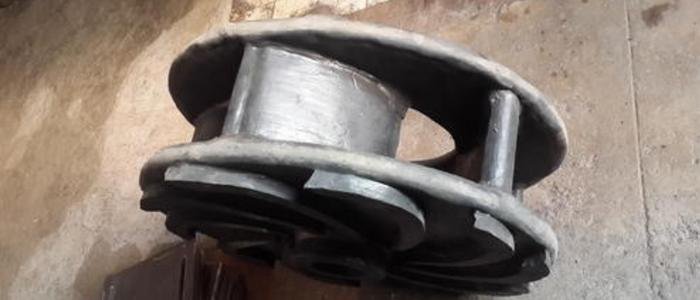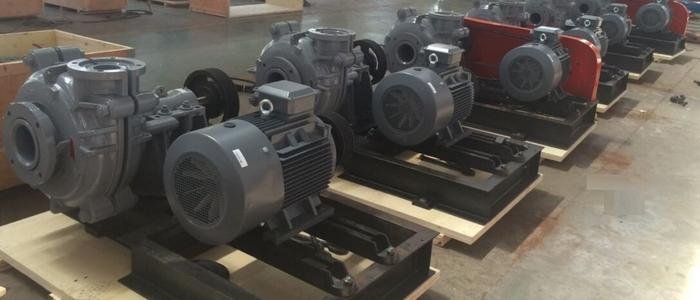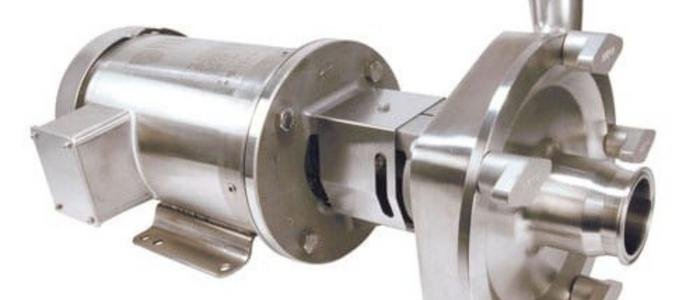A slurry pump impeller with a front shroud and a back shroud, each with an inner main face, an outer peripheral edge, and a central axis, and a plurality of pumping vanes extending between the inner prominent faces of the shrouds, the pumping vanes being spaced apart.
Each pumping vane has a leading edge in the central axis region and a trailing edge at the outer peripheral edges of the shrouds, with a passageway between neighboring pumping vans. Each passage has a discharge guide vane connected to it. Each discharge guide vane is disposed within a corresponding passageway, located closer to one or both of the pumping vanes, and extends from the inner main face.
What is an Impeller Slurry Pump?
The impeller is a critical component of your centrifugal pump. Depending on your application, impeller selection can significantly impact pump performance. Because of their abrasive character, slurry applications can tax your pump’s impeller. You must select the correct impeller for your process to run efficiently and last.
Types of an Impeller
In slurry applications, any form of the impeller can be utilized. However, open impellers are more frequent because they are less likely to clog. Closed impellers typically do not perform well with solids and are difficult to clean if blocked. At high densities, for example, microscopic fibers in paper stock may block the impeller. Slurry pumping can be difficult, and a clogged pump should be avoided whenever possible.
Size of the Impeller
Its size must be determined so the pump’s impeller can endure abrasive wear. Slurry propellers are typically larger than those used in pumps for less abrasive liquids. The more “flesh” a propeller has, the better it performs when pushing difficult slurry mixtures. Consider the pump’s impeller to be a football team’s offensive line. These players are usually large and slow. They are beaten up repeatedly throughout the game, yet they are expected to defy the brutality. Small pieces are undesirable in this role, like a small impeller on a slurry pump.
Pumping Rate
Your programming has little bearing on propeller choice, but it does have an impact on propeller life. Finding the sweet spot that allows the pump to run slowly while preventing sediments from settling and clogging is vital to find the sweet spot that allows the pump to run slowly while preventing deposits from settling and clogging. Because of its abrasive nature, the slurry can easily ruin the impeller if pumped too quickly. As a result, a larger propeller should be chosen.
When handling slurry, it is best to go bigger and slower. The stronger the impeller, the longer it will last. The less wear and tear on the impeller, the slower the pump.
However, the impeller is not the only component.
Examples of Propeller

Coarse coal pumping
Granules may cause blockages in a standard 5-vane closed propeller. It is possible that a one-of-a-kind huge 4-vane impeller will be required.
umping of fibrous material
Long fibers can become entangled in a typical impeller vane entrances. A modified choke-less impeller can be used for these activities.
Impellers with a smaller diameter
Reduced diameter impellers are necessary for some unusual instances but are generally avoided since impeller wear is more than with complete diameter impellers.
Eye impellers have been reduced.
In some very high-wearing applications, such as mill discharge, a tailored impeller with a reduced eye might extend impeller wear life.
Features of Impeller Slurry Pump

A slurry pump’s design is crucial to its efficiency. The slurry pump impeller is in charge of slurry movement and should be efficient enough to sustain the proper slurry flow. This impeller comprises a set of vanes that go from the center to the outer edge. The rotation of these vanes generates centrifugal force, which pushes the liquid to the pump casing’s outer edge and eventually out of the discharge port.
The type of slurry determines the impeller design of a slurry pump. The concentration of solids in the slurry is frequently used to classify it. On the other hand, the engineering classification is significantly more sophisticated and incorporates particle shape, weight, and size. The sort of abrasion that is likely to occur in the slurry pump is determined by this categorization. Its impeller is intended to handle specific slurries and can be powered either hydraulically or electrically.
Impellers can be created out of cast materials or metals. A cast impeller is also known as a rotor. A gearbox, which is usually connected to a motor, drives the impeller. Impellers are made from various metals depending on the working circumstances of a slurry pump. The impeller is a vital component of the pump, and it is critical to select the correct material.
Other Features:
– Advanced hydraulic model, CAD-aided design, excellent efficiency, and significant energy savings.
-Can produce parts based on your drawings.
– The impeller is built of a wear-resistant high chromium alloy with a maximum hardness of more than 60HRC and a long service life.
Application of Impeller Slurry Pump

Slurry pumps are commonly utilized in the mining industry’s beneficiation segment, where most facilities use wet separation systems. Throughout the process, these systems typically necessitate the flow of slurry.
Slurry pumps are also commonly utilized for thermal power plant ash disposal. Slurry pumps are also employed in manufacturing fertilizers, land reclamation, dredge mining, and long-distance transportation of coal and minerals.
Increased global focus on environmental and energy restrictions will probably result in far broader usage for slurry pumping in the coming years.
Advantages of Impeller Slurry Pump

Impellers last longer, reducing the frequency with which they must be replaced. The slurry is unable to stick to the propeller and clog the motor because the substance is smooth. These benefits add up to more efficiency and fewer issues when pumping slurry.
Slurry applications can technically employ any impeller. However, open impellers are typically favored because they do not clog as quickly. Closed impellers have low solids performance and are harder to remove or to wash if they become blocked.
When pumping slurry, the propeller size of the pump should also be addressed. Pumps that transport less abrasive liquids often have larger impellers than slurry pumps. Larger impellers can withstand the damage that strong slurry mixtures can throw out. The bigger the size, the quicker the rate. The less wear and tear on the impeller, the slower the pump runs.
The Important Reasons for Slurry Pump Impeller
Simply put, the slurry pump impeller is a portion of the impulse turbine rotor’s wheel of the wheel. Slurry pumps with impellers come in four varieties: closed impeller, semi-open impeller, half-open impeller, and open impeller.
Because the role of the slurry pump is used for liquid purification and transportation of pollutants, the wear is even stronger. Because the impeller is transporting significant equipment, wear is the most severe location to explain specific reasons for slurry pump impeller wear.
Cost of Impeller Slurry Pump
The strength of a closed propeller is boosted by adding more wall sections in front and behind the blade. It also reduces shaft costs, increases bearing life, and enhances delivering reliability. Because of their more complicated design, closed impellers are more expensive to construct than open impellers. As the wear ring distance increases, the efficiency of the closed impeller decreases. Closed propellers outperform genuine propellers across a more comprehensive speed range.
When dealing with particles, these impellers commonly used in high-volume clean-water pumps are useless. If they become clogged, they are difficult to clean.
Helpful Advice About the Best Impeller Slurry Pump
Centrifugal slurry pumps are commonly utilized to transport slurries containing less than 70% solids weight via pipelines. These pumps have enormous capacity but very short heads. Vertical, horizontal, and submersible centrifugal slurry pumps are available.
Positive displacement slurry pumps
To pump slurry through pipelines with a high solids concentration, slurry pumps must be able to offer high heads at limited capacities.
Submersible Centrifugal Slurry Pump
A submersible centrifugal slurry pump is a continuous flow pump that can handle abrasive slurries while working underwater.
Slurry Pump Impeller Tip Speed
Sizing and selecting a slurry pump is a complex task. Along with pump hydraulic and mechanical features (which we will not cover in this post but would be pleased to assist you with), it has become critical to consider impeller tip (or peripheral) speed, impeller revolutions per minute (RPM), and how these variables affect slurry pump wear. We provide a few options for calculating a pump’s wear rate based on tip speed, RPM, and impeller size.
If the impeller tip (or peripheral) speed is less than the maximum permitted tip speed, determined by the type of slurry being pumped and the impeller material, you’ve chosen the right slurry pump.
It is vital to note that the wear rate of a pump is related to the impeller tip speed, but it is more precisely related to the impeller revolutions per minute (rpm).
If you have any questions please contact us any time!


